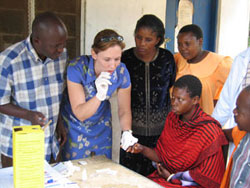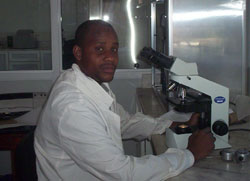 |
| April 25 is World Malaria Day, which commemorates the date in 2000 when 44 African leaders committed to cutting malaria deaths in half by 2010. This year's World Malaria Day theme is "Counting Malaria Out." How does CDC contribute? |
|

Dr. Bakari Amuri, Ifakara Health Institute, and Dr. Meredith McMorrow, CDC, train health workers at Bungu Dispensary, in Rufiji District, Tanzania, to take blood samples. Credit: S. Patrick Kachur, CDC |
 |
CDC Helps Count Malaria Out
CDC's mission to combat malaria began when it was founded as an agency to eliminate malaria from the United States. After elimination in the United States in 1951, CDC's focus in malaria turned to prevention, research, surveillance, and technical support, both in the United States—to prevent the return of malaria—and globally, where each year malaria causes the death of approximately 1 million people, mostly young children in Africa.
CDC's long history of work in malaria control and prevention has included seminal research to define the malaria control and prevention tools that are being used today in the ramped-up fight against malaria. CDC maintains its focus on tools for tomorrow by continuing to conduct strategically targeted research to refine and evaluate new tools and strategies for new policies to further reduce illness and death due to malaria.
One current CDC research project focuses on enabling malaria control officials to track malaria drug resistance better, a major threat to effective malaria treatment in the last 3 decades. For example, one safe, effective, inexpensive, and widely used antimalarial drug, chloroquine, can no longer be used in most areas of the world because the malaria parasite has developed resistance to it.
In collaboration with investigators in malaria-endemic parts of Africa, Latin America, and Southeast Asia, CDC is focusing on developing new drug resistance monitoring systems based on 1) identifying parasite molecular markers to help determine if a person is infected with a potentially drug-resistant parasite, and 2) growing live parasites from patients in the laboratory to see if they are starting to become resistant to currently recommended drugs.

Microscopist Christopher Membi reads slides for malaria diagnosis at Ifakara Health Institute, Bagamoyo. Credit: Deborah Sumari, Ifakara Health Institute
Without the use of these methods, the only practical way to determine whether the malaria parasite is becoming resistant is to directly observe dozens of patients with malaria while they take a recommended antimalarial drug and then follow them for 4-6 weeks to observe how quickly and completely they recover. However, this is logistically difficult: many people who go to health facilities for treatment live far from the facility, and finding enough malaria-infected patients is getting more and more difficult as malaria control efforts succeed and malaria transmission falls.
Concentrating on these newer techniques may make it possible to detect potentially resistant parasites more efficiently and predict drug resistance before it becomes well established. Armed with this information, malaria control program managers can promptly switch to a more effective treatment and therefore save lives.
In addition to its portfolio of programmatically relevant research, CDC also contributes to global prevention and control efforts through the President's Malaria Initiative, a U.S. government interagency initiative begun in 2005 to halve malaria deaths in 15 countries in sub-Saharan Africa. PMI is led by the U.S. Agency for International Development (USAID) and is implemented jointly by USAID and CDC, in close collaboration with host ministries of health and other local and international partners in the public and private spheres.
Page last modified : April 21, 2009
Content source: Division of Parasitic Diseases
National Center for Zoonotic, Vector-Borne, and Enteric Diseases (ZVED)
|
 |
|




